Cockatiels are incredibly popular pet birds that come in an engaging array of colors and patterns. Some of these mutations are common while others are unusual or even exceptional. Starting with the most common mutation and ending with the rarest, we’ll work our way through 19 cockatiel colors currently on the market.
1. Normal Grey
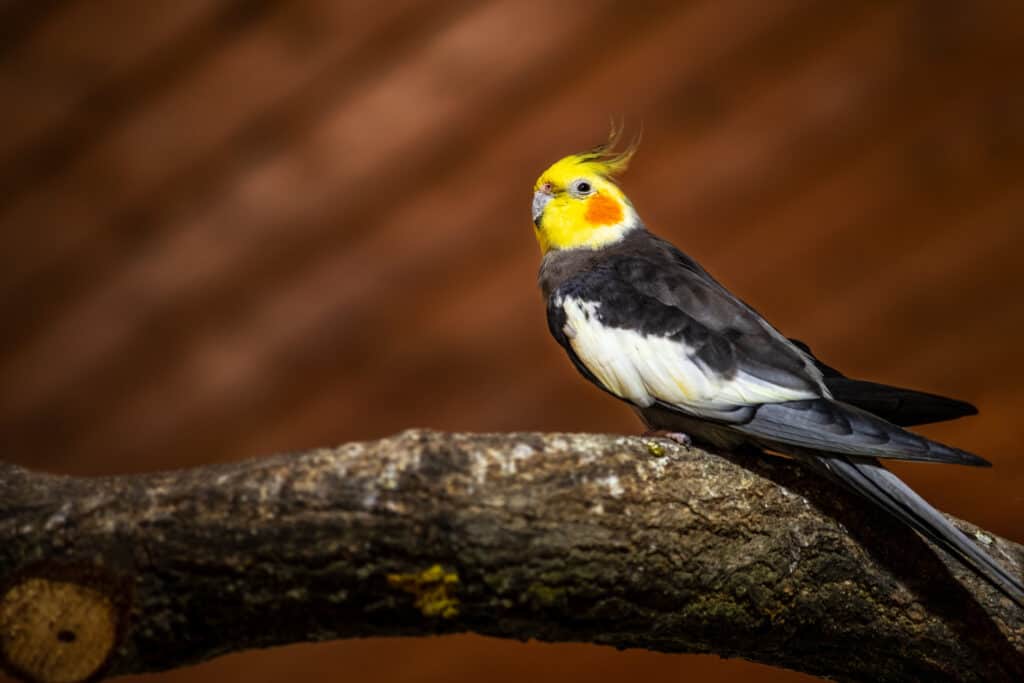
The normal grey cockatiel is the original and most common type.
©iStock.com/Vronja_Photon
The original and most common cockatiel color is grey or “normal grey.” Cockatiels with this coloration are also called “wild-type cockatiels.” Because it’s so common, this type of cockatiel is usually the cheapest to buy.
As its name suggests, its feathers are primarily grey with white markings on its wings and tail. Adult males have yellow faces with vibrant orange cheek patches. Females and juveniles are similar but duller. Yellow or white feathers on the back of the head indicate a recessive pied mutation.
2. Pied
Another common cockatiel color is the pied mutation. This type originated in the 1950s, marking the first time anyone deliberately bred a cockatiel color mutation. Pieds combine vibrant yellows and whites with light and dark grey hues. Because they have patches of missing pigmentation, no two pieds are exactly alike. Cockatiels with only one copy of the pied gene often have random yellow or white feathers.
3. Lutino Pied
Similar to the pied but less common, the lutino pied features darker yellow patches.
4. Clear Pied
A less common pied mutation is the clear pied. Similar to the pied, its distinguishing feature is the lack or near lack of dark feathers on the face and chest. It also lacks red eyes.
5. Pearl Pied
Also similar to the regular pied, the pearl pied is grey with a white or yellow head. Its pearling is limited to patches on its wings.
6. Cinnamon
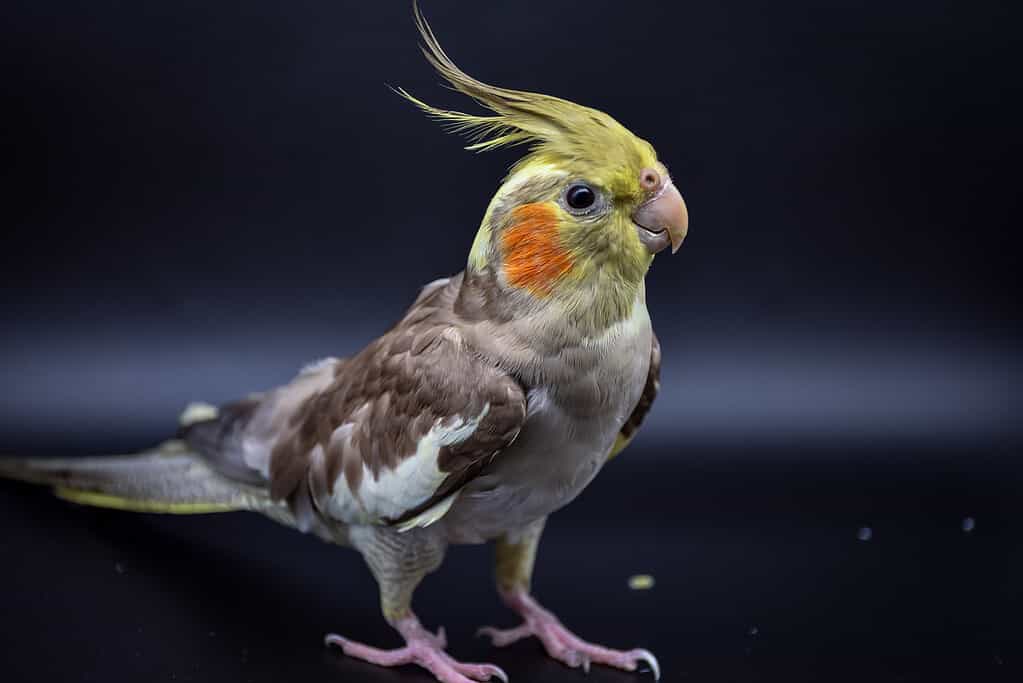
The cinnamon cockatiel has tan or cinnamon feathers instead of grey.
©Oleg Spiridonov/iStock via Getty Images
Another very common cockatiel mutation is cinnamon. In this mutation, the normal grey cockatiel’s feathers are tan or cinnamon brown instead of grey. The male boasts a striking yellow face with bright orange cheek patches. The female’s cheek patches are duller; females also lack yellow facial coloration. The underside of their tails sport white or yellow bars.
7. Cinnamon Pied
A less common cinnamon variation is the cinnamon pied, which is the result of crossing pieds with cinnamon. These cockatiels are a mixture of cinnamon and yellow. Markings vary from bird to bird, making each unique.
8. Cinnamon Pearly
Another less common cinnamon variation is the cinnamon pearly. This cockatiel’s distinguishing feature is its variable cinnamon-and-pearl feathers, which also sport yellow edging.
9. Cinnamon Pearly Pied
A third uncommon cinnamon mutation is the cinnamon pearly pied. This is a combination of the cinnamon pied and the cinnamon pearly.
10. Lutino
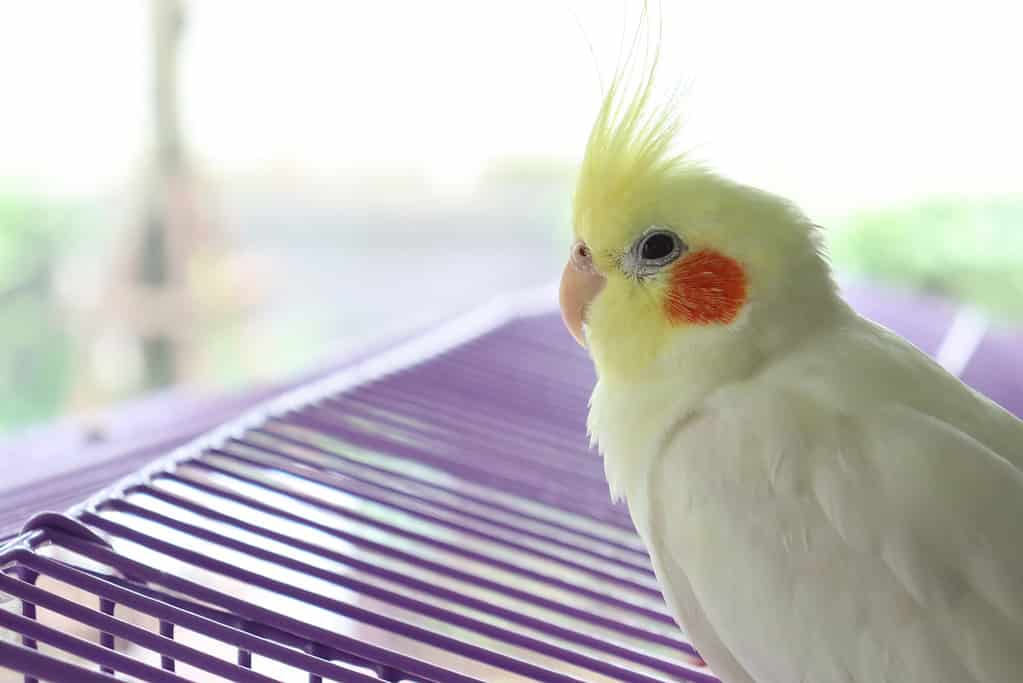
The lutino cockatiel is one of the most common color mutations.
©Chutima Chavanisakun/iStock via Getty Images
The lutino cockatiel is another very common color mutation. This type does not produce melanin, rendering its feathers white instead of grey. Occasionally, the wings are tinted yellow. Its face is yellowish with orange cheeks and red eyes. Females often have yellow bars on the undersides of their tails and bright yellow feathers under their wings.
When breeders first began producing this type of cockatiel, it was common to see pronounced bald spots behind the crest. This was primarily the result of inbreeding. Although this feature persists today, it is less pronounced due to more responsible breeding practices.
11. Lutino Pearl/Lacewing
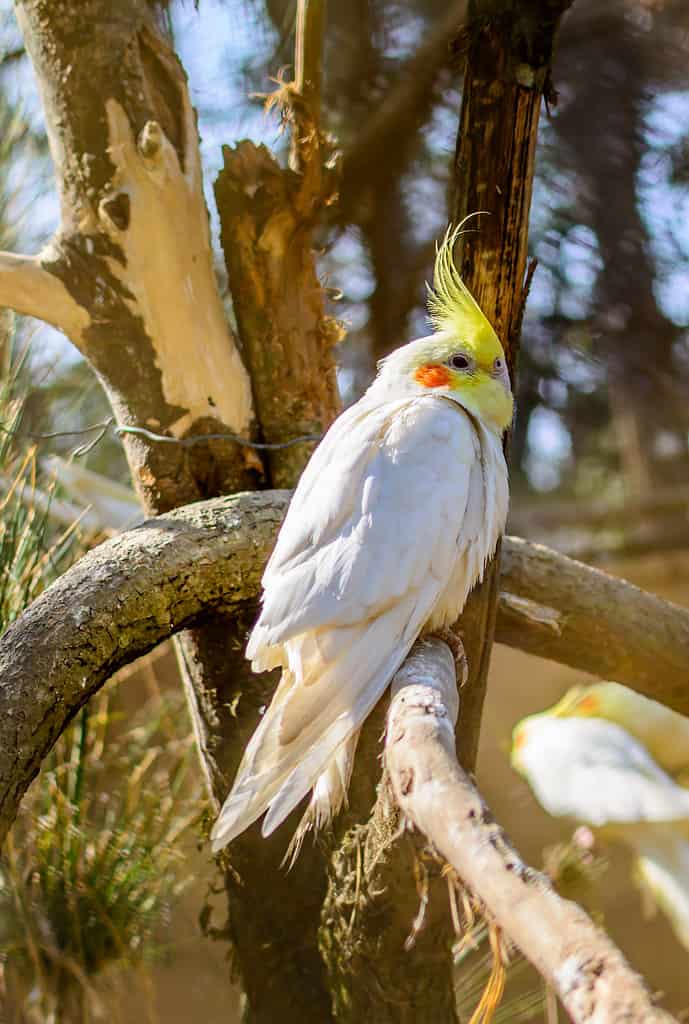
The Lutino pearl is a variation of the more common lutino cockatiel.
©Sumit_Kumar_99/iStock via Getty Images
A popular Lutino variation is the Lutino pearl. This mutation features darker yellow pearling as well as a combination of white, light grey, and dark grey feathers.
12. Pearl

The pearl cockatiel is a lighter variation of the normal grey cockatiel.
©Sara Ruiz/iStock via Getty Images
The pearl cockatiel is a lovely but uncommon variation of the normal grey cockatiel. Pearly markings (called “pearls”) occur on its head, wings, and body. Most pearls are white, though some are yellowish. The cheeks are typically orange against a white or yellowish face.
The first deliberate breeding of the pearl cockatiel took place in 1970. Interestingly, males lose most of their pearls after molting and revert to normal grey. Females, on the other hand, usually retain their pearling into old age, making them the more popular choice.
13. Emerald/Spangled/Olive
The emerald cockatiel, also called the spangled or olive cockatiel, first came about in the 1980s as the 13th color mutation. Its name derives from its light grey and yellow spangling as well as its faint greenish tint. This tint is the result of a dilute gene that causes reduced melanin production and reveals yellow pigmentation. The mutation is fairly uncommon.
14. Fallow
The fallow cockatiel is a recent and uncommon mutation that only arrived on the scene in the early 1970s. Similar to both the cinnamon and silver mutations, this variant is silvery with a subtle yellowish-cinnamon tinge. The wings and underside may also show some grey coloring. The face is often yellow with red eyes and no cheek patches. Unfortunately, inbreeding has caused vision problems in some individuals.
15. Yellowface
This cockatiel mutation is relatively rare. It’s very similar to the normal grey cockatiel but with yellow cheek patches instead of orange. Some individuals also sport yellow feathers on top of their heads.
16. Blue
The blue cockatiel is one of the rarest mutations on the market. Its body is entirely white except for black markings on its wings and blue markings on its tail. The face lacks cheek patches and, in most cases, also lacks a yellowish tint.
17. Silver
Another rare cockatiel mutation is the silver cockatiel. Multiple pigment gene variations give this type its silvery-grey coloration. Individuals with the single-factor dominant silver mutation sport a darker metallic hue while those with the double-factor dominant silver mutation are lighter. The wing and tail feathers typically feature white markings. The head is yellowish with yellow or orange cheeks and red eyes.
18. Albino/White-face Lutino
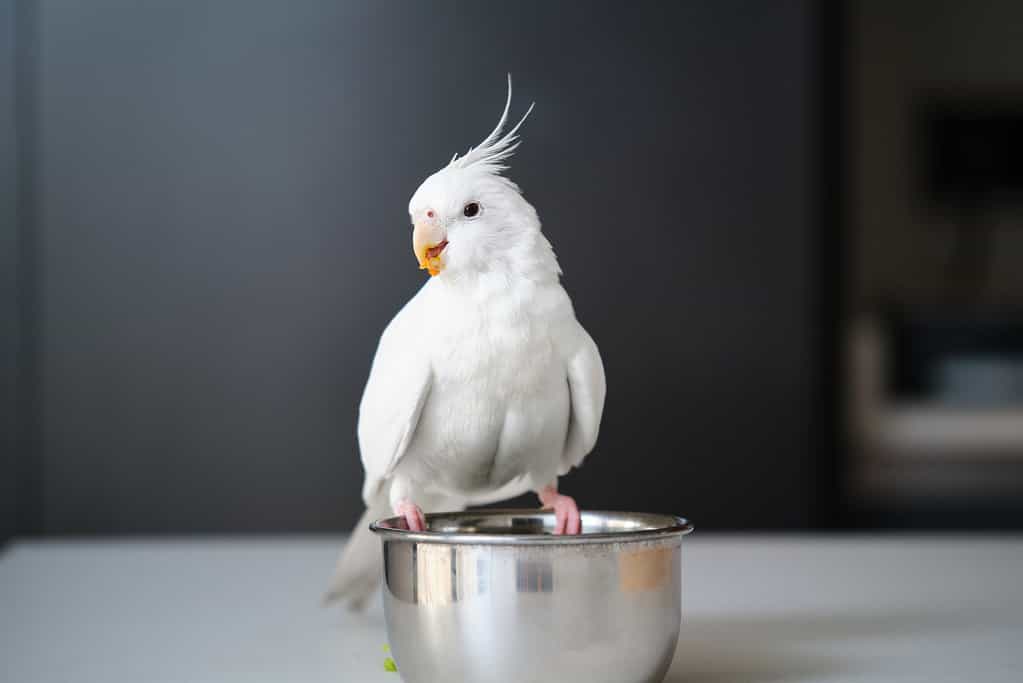
The albino cockatiel is not a true albino as it lacks the blue gene.
©Ladanifer/iStock via Getty Images
One of the rarest cockatiel colors is the albino cockatiel, also called the white-face lutino. Because it lacks pigmentation, this bird is entirely white with red eyes. Females may also have bars on the undersides of their tails. Despite its name, this variation is not a true albino as it lacks the blue gene.
19. Whiteface
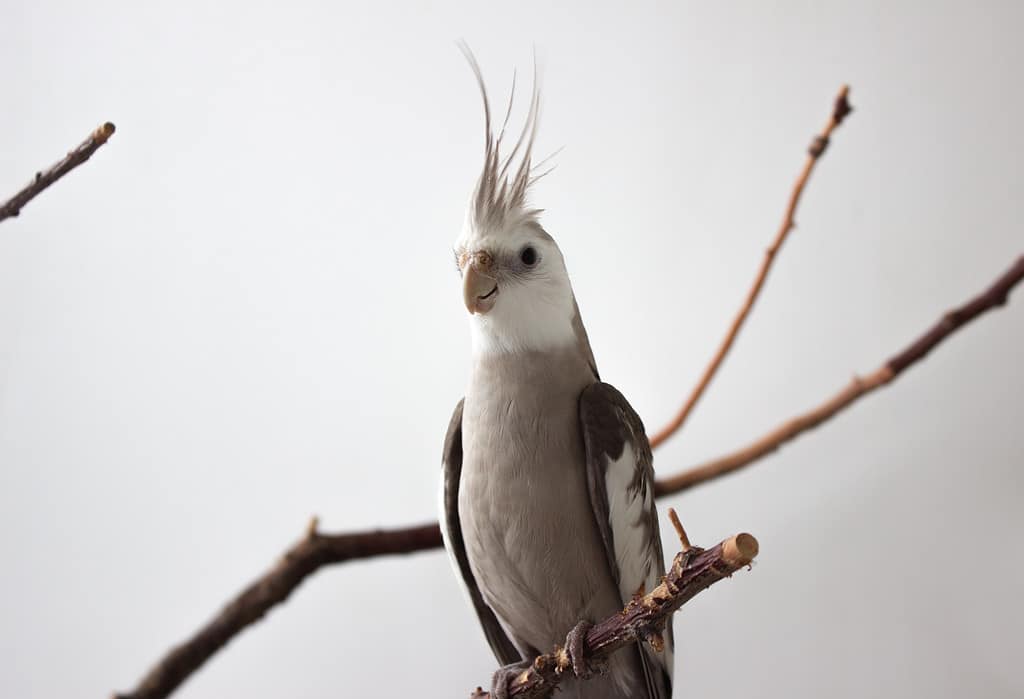
The whiteface cockatiel is the rarest cockatiel mutation.
©DariaAusheva DariaAusheva/iStock via Getty Images
The whiteface cockatiel is the rarest cockatiel mutation and is therefore the most expensive to purchase. As its name suggests, the male whiteface’s head is completely white with no cheek patches. The female also lacks cheek patches but may develop a grey face. The body is white with grey streaks.
The pastel face cockatiel is a variation of this rare mutation. Males of this type sport peach cheek patches against a yellow face.
Conclusion
Anyone looking to own a cockatiel has a stunning array of cockatiel colors and patterns to choose from. The birds near the bottom of this list typically cost more than those near the top due to their rarity. Some mutations also suffer from common medical issues related to inbreeding, so exercise caution when selecting a type to bring home.
Summary of Cockatiel Color Variations
| Coloration | Rarity | |
|---|---|---|
| 1 | Normal Grey | Most Common |
| 2 | Pied | Common |
| 3 | Lutino Pied | Less Common |
| 4 | Clear Pied | Less Common |
| 5 | Pearl Pied | Less Common |
| 6 | Cinnamon | Very Common |
| 7 | Cinnamon Pied | Less Common |
| 8 | Cinnamon Pearly | Less Common |
| 9 | Cinnamon Pearly Pied | Uncommon |
| 10 | Lutino | Very Common |
| 11 | Lutino Pearl/Pacewing | Common |
| 12 | Pearl | Uncommon |
| 13 | Emerald/Spangled/Olive | Uncommon |
| 14 | Fallow | Uncommon |
| 15 | Yellowface | Rare |
| 16 | Blue | Very Rare |
| 17 | Silver | Rare |
| 18 | Albino | Very Rare |
| 19 | Whiteface | Rarest |
The photo featured at the top of this post is © iStock.com/PaulGulea
Thank you for reading! Have some feedback for us? Contact the AZ Animals editorial team.







